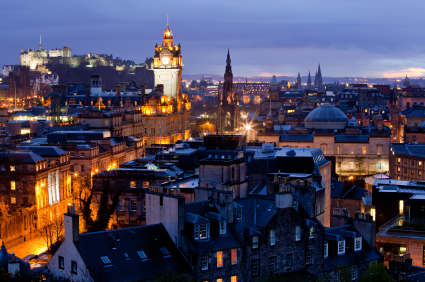 Edinburgh is Scotland’s capital city and one of the most economically active cities in the United Kingdom. As such, change and transformation are essential elements in the social and economic life of this city. In recent years, Edinburgh has won a number of accolades that have attracted further investment and new residents, such as the European Destination of the Year 2012 award, the Best Large City for Foreign Direct Investment 2012-2013 recognition, and the Best UK City award. In this article we look at the changes that the Scottish capital has gone through in the recent past in terms of demographic, economic, and industrial patterns.
Edinburgh is Scotland’s capital city and one of the most economically active cities in the United Kingdom. As such, change and transformation are essential elements in the social and economic life of this city. In recent years, Edinburgh has won a number of accolades that have attracted further investment and new residents, such as the European Destination of the Year 2012 award, the Best Large City for Foreign Direct Investment 2012-2013 recognition, and the Best UK City award. In this article we look at the changes that the Scottish capital has gone through in the recent past in terms of demographic, economic, and industrial patterns.
Demographic changes in Edinburgh
Today, Edinburgh is a bustling metropolis with a population of over 482,000 people, a figure that indicates that over 9 per cent of Scotland’s total population lives in the city. Edinburgh’s larger urban zone has a population of more than 817,000.
Population growth indexes have been rising in Edinburgh for more than two decades. Growth indexes were significant in the decade of the 1990s, when year-on-year population numbers increased by up to 7 per cent. Currently, growth trends have been rather moderate (yet still positive), with a 1 per cent increase in population between 2011 and 2012.
When compared to the rest of Scotland, Edinburgh has a large percentage of population in the 16 to 29 age group. Approximately 24 per cent of Edinburgh’s residents fall within this age group, as opposed to the Scottish average of 18 per cent. On the other hand, the percentage of residents aged 65 and over is smaller in Edinburgh than it is in the rest of Scotland, with 19 per cent of the population being in this age group, as opposed to 23.5 per cent in other parts of the region. As of 2012, the largest age group in the city is made up of those between 45 and 59 years old, followed by the 30 to 44 category. This points at an increase in the number of working professionals that have chosen to relocate to the city from other parts of Scotland and the UK. The large numbers of residents in these age groups are also a result of the immigration waves experienced in the city since the early 2000s, when large groups of Eastern European citizens moved to the city.
In 2012, birth rates were slightly up by 0.8 per cent, a figure that is somewhat lower than the Scottish average. This may be due to the fact that a large number of young couples in the city are working professionals who are increasingly deciding to postpone parenthood.
It is expected that by 2035, the city’s population will reach 611,000.
Economic trends in Edinburgh
According to data published by the Edinburgh Chamber, the city has the country’s second highest average gross annual earnings, with £27,800 per resident. This is directly linked to the highly skilled workforce of the city, as it is estimated that more than 43 per cent of Edinburgh’s population is educated to university degree level.
Overall, the city’s economy is considered to be the second strongest in the UK after London and the most competitive in the country. This represents a big change in Edinburgh’s economic make-up, which had traditionally depended on activities like brewing, publishing, and banking. The diversification of the economy has resulted in the creation of large numbers of jobs. Nowadays, 71 per cent of the city’s population is economically active, and the current unemployment rate is 6 per cent.
Edinburgh Council’s economic strategy expects to continue driving economic growth through the creation of jobs. It is expected that by 2017, 20,000 new jobs will have been created, and £1.3 billion worth of investments will be brought into the city.
Industrial trends in Edinburgh
Banking and insurance remain the most important industrial sectors in Edinburgh, yielding combined outputs of £4.6 million a year. Next are public administration, education, and health, followed by distribution, transport, accommodation, and food services.
As of 2012, the city’s largest employers were Edinburgh’s City Council, NHS Lothian, Lloyd’s Banking Group, the Royal Bank of Scotland, the University of Edinburgh, Standard Life Insurance, and the Scottish Government.
Tourism has also become one of the most important sectors in Edinburgh. In 2012, the tourist industry in the city generated revenues for the value of £2 billion. It is expected that this industry will continue to grow in Edinburgh, creating more than 8,000 jobs by 2020.

